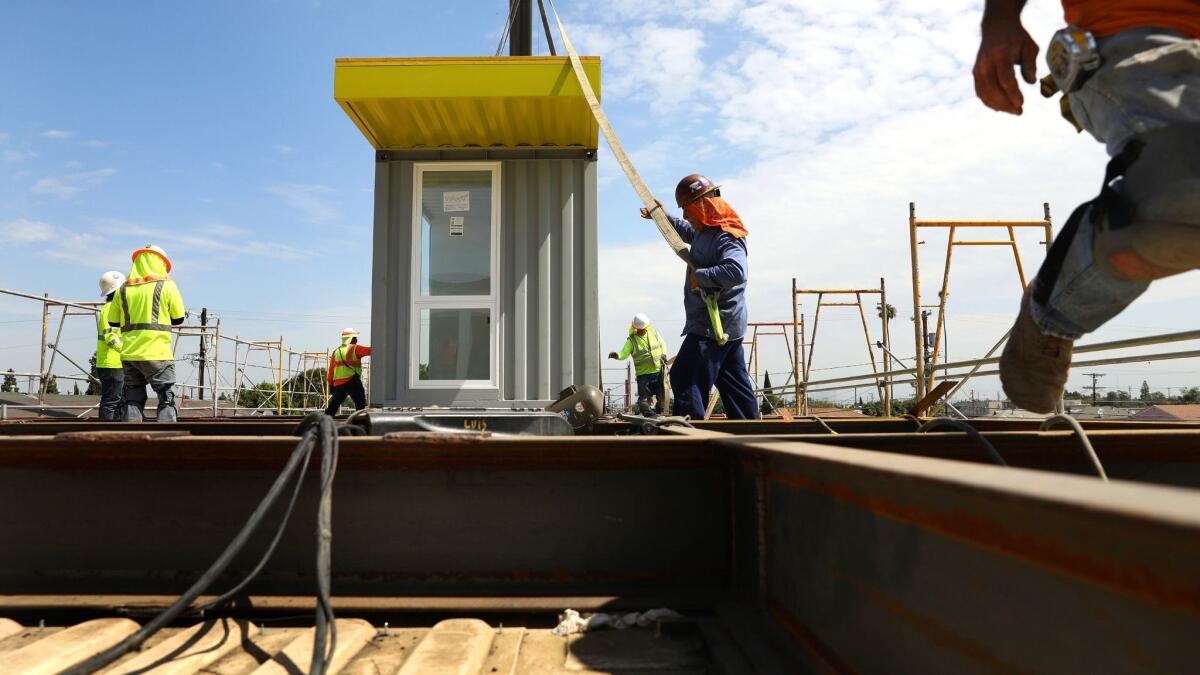L.A. approves $120 million to encourage building faster, cheaper homeless housing

Wanted: Fresh ideas to speed up the construction and lower the cost of housing for homeless people — without cutting quality.
The Los Angeles City Council made that pitch formal on Tuesday, voting 14-0 to set aside $120 million, a substantial slice of the Proposition HHH homeless housing bond, for a pilot program that will ask developers for strategies to change the way publicly subsidized housing is built.
The vote authorized Mayor Eric Garcetti to seek proposals for 1,000 units of supportive housing as a test of alternatives to the slow and increasingly costly method of building conventional apartments for homeless people using traditional tax-credit financing.
Backyard flats, rehabbed single-room-occupancy units, shared housing, honeycomb pre-fabs. All will be considered, though not all will necessarily be approved.
Besides being quick and cheap, winning proposals must include space and a plan backed by a homeless agency to provide services for the people who will live there.
And they can’t be schlock.
“We want a program that can create high-quality projects that can demonstrate long-term financial and physical durability,” Ben Winter, the mayor’s chief housing officer, told members of the Proposition HHH citizen oversight committee when he unveiled the plan in December.
“We’re not building them for six months of housing,” he said. “These are long-term neighborhood benefits.”
Garcetti has enthusiastically backed the plan, which was created last year after committee members became dissatisfied with the progress and cost of the bond program.
In addition to being an experiment in new housing types, the pilot also is a call for ways to bypass the traditional method of financing affordable and homeless supportive housing, which requires developers to assemble grants and loans from local and state programs as a foundation for highly competitive tax credits.
Only a handful of nonprofits and for-profit developers proficient in the labyrinth of tax-credit financing and capable of providing supportive services have, so far, been able to access the $1.2 billion in bond funds provided under Proposition HHH.
Those groups had been building about 300 units of supportive housing in the city annually when voters, in effect, asked for that rate to nearly triple by approving the 2016 bond measure with a promise of 10,000 units within a decade.
The city’s Housing and Community Investment Department told the City Council on Tuesday that the pace has picked up. Fifty-five projects have received conditional or final commitments for Proposition HHH funding. Collectively, those projects would produce more than 3,712 units, of which 2,810 are reserved for supportive housing. Another 26 projects are under review.
So far, however, only eight of those projects are under construction, and members of the citizen committee appointed to monitor the bond program have chaffed at the delays.
Even more alarming to committee members has been the rising cost. Housing construction that hovered at $400,000 per unit before Proposition HHH is now routinely above $550,000 per unit — a rate that would exhaust Proposition HHH funds well short of the 10,000-unit goal.
Last year, the committee, led by former Los Angeles City Administrative Officer Miguel Santana, issued increasingly dire warnings that something needed to be done to save Proposition HHH.
In the fall, it began asking developers to its meetings to propose newer, cheaper models for developing housing.
The exercise reached a defining point when the head of a company named FlyawayHomes reported that it had built a shipping container project of 33 housing units that was entirely financed by private investment and that it had started construction on a second.
FlyawayHome’s founder, Lawry Meister, told the committee that she could build nearly 2,000 units in three years if the city would fund 100% of the cost in short-term loans — a radical shift from the standard practice of issuing loans that that can be deferred indefinitely.
Meister said her company would repay the loans through an “exit strategy” involving social benefit investments — funds put up by people seeking a modest return for doing good deeds — or through conventional financing.
In November, the citizen oversight committee adopted an 11-point recommendation plan, including the pilot program discussed Tuesday. The recommendations also called for many city regulations to be relaxed and other incentives such as low-interest loans.
A month later, Winter reported to the committee that the mayor would propose using $120 million — or 10% of the Proposition HHH bond — in an open-ended competition for innovative development projects.
On Tuesday, Winter told the council: “The mayor is really excited about carving out a space to really encourage the private sector in looking at alternative ways to construct and/or finance supportive housing.” The mayor, he said, planned to release a request for proposals by March that would “open the box for developers.”
The process will be modeled after the process devised by the Los Angeles County Homeless Initiative to vet entries in an innovation competition for $5 million funded through the countywide Measure H homeless sales tax.
The county issued what Winter described as “an open call for the best and brightest ideas in the private sector.” Winners have been chosen, but not yet announced.
FlyawayHomes said it was among the winners and has received a $1-million award for its second project. It was unclear, however, whether the company’s proposal requiring 100% HHH financing would succeed under the city’s much larger pilot program.
The city’s request for proposals will not hold housing projects to the current HHH subsidy limits, among them allowing public subsidies of no more than 50% of the total cost of a project. But there is a limit to how much the city can risk on projects requiring 100% funding.
More to Read
Sign up for Essential California
The most important California stories and recommendations in your inbox every morning.
You may occasionally receive promotional content from the Los Angeles Times.











